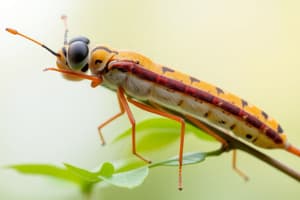Podcast
Questions and Answers
What tools are used to classify organisms into taxonomic groups?
What tools are used to classify organisms into taxonomic groups?
Molecular phylogenetics, comparative anatomy, morphological traits, niches/interactions with the abiotic and biotic environment, etc.
How do cladistic methods differ from traditional taxonomic methods?
How do cladistic methods differ from traditional taxonomic methods?
Cladistic methods use comparative analysis of DNA/RNA/amino acid sequences to determine common ancestry, unlike traditional methods that focus on morphological similarities.
Explain why a classification system is needed.
Explain why a classification system is needed.
Classification is needed because of the immense diversity of species, it allows for an organizational structure for biology, enables international cooperation due to a worldwide species nomenclature system, and assists in research on species patterns and trends.
Describe difficulties with the traditional hierarchy of taxa.
Describe difficulties with the traditional hierarchy of taxa.
Describe the advantages of basing classification on evolutionary relationships.
Describe the advantages of basing classification on evolutionary relationships.
Define 'taxonomy'.
Define 'taxonomy'.
List the levels of classification in the traditional hierarchy of taxa.
List the levels of classification in the traditional hierarchy of taxa.
List the 5 kingdom classification system.
List the 5 kingdom classification system.
What characterizes Prokaryotae?
What characterizes Prokaryotae?
What characterizes Protocistista?
What characterizes Protocistista?
What characterizes Fungi?
What characterizes Fungi?
What characterizes Plantae?
What characterizes Plantae?
What characterizes Animalia?
What characterizes Animalia?
Why is molecular phylogeny a better form of classification than morphology?
Why is molecular phylogeny a better form of classification than morphology?
What is phylogenetic classification?
What is phylogenetic classification?
Define clade.
Define clade.
Flashcards are hidden until you start studying
Study Notes
Classification Tools
- Molecular phylogenetics, comparative anatomy, and morphological traits are key tools for classifying organisms.
- Understanding niches and interactions with both abiotic and biotic environments is essential for classification.
Cladistic vs. Traditional Taxonomy
- Cladistic methods analyze DNA, RNA, and amino acid sequences to trace common ancestry.
- Traditional taxonomy often relies on arbitrary morphological similarities, potentially misleading classifications.
Importance of Classification
- Classification is vital due to the vast number and diversity of species.
- It provides an organizational structure for biological science and facilitates global cooperation via a standardized nomenclature system.
- Helps researchers observe patterns and trends in species.
Challenges with Traditional Taxonomic Hierarchy
- Traditional hierarchy is considered arbitrary and does not accurately reflect evolutionary relationships.
- Examples include misconceptions drawn from shared characteristics (like wings) that do not account for underlying genetic differences.
Advantages of Evolutionary Classification
- Reflects true evolutionary relationships, grouping organisms based on common ancestry in clades.
- Captures the evolutionary process, indicating branching patterns and speciation.
- Allows predictions on organisms' characteristics, like biochemistry and ecology.
- Provides context for understanding the diversity and distribution of life on Earth.
Definition of Taxonomy
- Taxonomy is the science of categorization, organizing living organisms based on set criteria.
Levels of Classification
- Traditional taxonomic hierarchy includes: Life, Domain, Kingdom, Phylum, Class, Order, Family, Genus, Species, Subspecies.
Five Kingdom Classification System
- Comprises Prokaryotae, Protocista, Fungi, Plantae, and Animalia.
Characteristics of Prokaryotae
- Unicellular, simple cell structure without a nucleus; includes bacteria and cyanobacteria.
Characteristics of Protocista
- Mostly unicellular eukaryotes with complex cell structures and nuclei, resembling ancestral fungi; includes seaweed and algae.
Characteristics of Fungi
- Predominantly multicellular and non-motile; obtain nutrition heterotrophically with complex cell walls lacking cellulose (e.g., yeast, mushrooms).
Characteristics of Plantae
- Multicellular, non-motile organisms that utilize autotrophic nutrition and possess cell walls; all are eukaryotic (e.g., apple trees).
Characteristics of Animalia
- Multicellular, eukaryotic, and heterotrophic organisms; reproduce sexually and asexually; do not have cell walls (e.g., humans, insects).
Molecular Phylogeny vs. Morphological Classification
- Molecular phylogeny is superior as it reveals true evolutionary relationships, distinguishing homologous structures from analogous structures.
- Morphological similarities can mislead classifications due to convergent evolution and mimicry.
Phylogenetic Classification
- Organisms are classified based on evolutionary history and relationships, using biochemical data to construct phylogenetic trees.
Definition of a Clade
- A clade consists of an ancestral organism and all its evolutionary descendants, forming a group that shares a common ancestry.
Studying That Suits You
Use AI to generate personalized quizzes and flashcards to suit your learning preferences.




